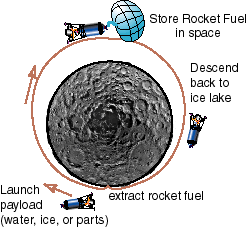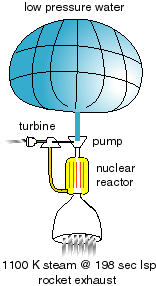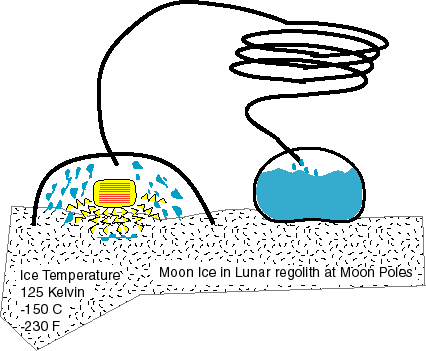

These cost reductions depend (exponentially) on the mission delta-v requirements being less than about 6 km/s, or about 3 times the specific velocity of steam rockets (2 km/s, from Isp 200 sec). Such missions include: from the Lunar Surface to Low Lunar Orbit, (LLO), from LLO to Lunar Escape, from Low Earth Orbit (LEO) to Geosynchronous Orbit (GEO), from LEO to Earth Escape, from LEO to Mars Transfer Orbit, from LLO to GEO, missions returning payloads from about 10% of the periodic comets using propulsive capture to orbits around Earth itself, and fast, 100 day missions from Lunar Escape to Mars.
All the assertions depend entirely and completely on the existence of abundant, nearly pure ice at the permanently dark North and South Poles of the Moon.
The Idaho National Engineering and Environmental Laboratory (INEEL), a United States Department of Energy (DOE) national laboratory, proposes an alternative to electrolysis:



The chemical propulsion system would need to do the same job, namely to deliver 14,400 tons per year to lunar escape. That system required between 1080 and 8100 tons of electric generators; the water splitters and liquefiers required between 420 and 4,400 tons. The total required mass for the electrolysis system was between 1,480 tons and 12,500 tons (totals for upper and lower limits). This chemical propulsion system would require 100 to 1000 times more hardware mass on the lunar surface than the steam system while delivering the same yearly payload. The hardware mass required for electrolysis is about 1000 times heavier than the steam rocket system..
In addition, analyses showed that steam rocket water containers weigh so little that engine-tank-structure assemblies weighing only tens of tons could propel payloads with masses between 1000 and 10,000 tons (reference 6, 10).
[[simple]]
In addition to savings in hardware, the steam rocketís propulsion system
offers cost savings over electrolysis systems. Systems where electricity
provides the energy for propulsion all have a common step: they must reject
heat radiatively to space (Figure 5). Radiative heat transfer to the vacuum
of space limits the electric power produced per unit hardware mass. The
available electric power limits the LOX/LH2 production rate, which is orders
of magnitude lower than that of the steam rocket architecture.

These costs are significant when put in the context of manning and maintaining a permanent space system. As with other systems, the number of processes that must operate in sequence and with extreme reliability significantly increase the cost to operate a space system. The chemical propulsion option has many such elements, contrasting the few elements for the steam propulsion option (Figure 5).
The issue of practicality is crucial when investigating the potential of utilizing lunar ice for space exploration. One needs both a nearly limitless source of ice and people to man the operations. Only missions that are short enough for humans to endure and use affordable hardware are candidates for practicality. Moon missions were practical three decades ago in duration (~days) and affordability (~$20 B or less). Recent literature indicates that missions to a comet or asteroid are indeed practical today (e.g. have reasonably achievable mission delta-V), but the duration of four or more years makes exploration unfeasible (reference 14).
Only the moon offers sufficiently short manned round trip times to make
exploration a reality. The use of lunar ice to provide steam propulsion
could provide the answer to solving the issue of cost and practicality
and lead to the next generation of space exploration.
All architectures using LH2 and those using LOX, derived from electrolysis of water, chemical fueled rockets, liquid hydrogen propellant, nuclear thermal rockets or solar thermal rockets satisfy the first condition. All architectures using electricity to accelerate masses including all ion engines, spark jets, arc jets, electric thrusters, rail guns launching mass off the surface of the moon or asteroids also satisfy the first condition.
The second condition (mission delta-V less than about 6000 m/s) is satisfied
by missions from the Lunar Surface to LLO, from LEO to GEO, from LLO to
Lunar Escape, from Lunar Escape to GEO; missions returning payloads from
about 10% of the periodic comets using propulsive capture to orbits around
Earth itself; and, 100 day missions from Lunar Escape to Mars. The first
and second conditions are satisfied for most missions between Venus and
Jupiter.
The alternative, chemical propulsion, must convert the heat to electricity, dump waste heat doing so, operate an electrolysis unit to split water, manage separate oxygen and hydrogen gas streams, operate mechanical refrigerator-compressor systems to liquefy oxygen and hydrogen gasses, reject heat for these processes, operate separate storage and transfer systems for cryogenic liquids. Rejecting heat to the vacuum of space requires relatively massive radiators, because the vacuum of space provides an environment like that of a thermos jar. The tanks for the cryogenic liquids must contain approximately one atmosphere and must be insulated and refrigerated to cryogenic temperatures.
3.2 Electricity
Electric generators in space are limited by the Second Law of Thermodynamics
to operate no more than Carnot efficiency: they must reject heat to
generate electricity. All known space electric generators have a thermal
efficiency less than 20%. They reject at least 5 times more energy to space,
radiatively, than electricity they generate.
Space electric generators can only reject heat by radiation to space, unless they are in contact with a thermal heat sink. The Stephan-Boltzman relation (fourth power of temperature law) limits the heat loss rate for practical radiators. Further, all radiators in space must be armored to mitigate the effects of micro-meteors. For example, a radiator operating at 1100 Kelvin with an emissivity of 0.5 using a 2 mill thick membrane to contain zero grams of thermal conducting fluid (extremely conservative), with structure and armor of 20 mills of radiating material, with density 3 (ceramic), and operating as a heat dump for a 20% efficient electric generator would achieve no more than 5.5 Megawatts per ton (0.18 kg/kw).
Space electric generators are characterized by the system mass in kilograms to generate one kilowatt of power, expressed as the reciprocal of megawatts per ton. The most optimistic electric generator proposed to be practical was quoted at 7.8 kg/kw (0.12 Megawatts per ton) (reference 15). Typical space electric generators cannot do better than 15 to 200 kg/kw. (0.066 to 0.005 Megawatts/ton).
In comparison, a steam rocket does not require electricity, and it generates
200 Megawatts per ton..
The convective thermal heat sink properties of ice fields of moons may offer a way to produce LOX and LH2 competitive with steam rocket systems. The resulting increase in specific impulse (400 sec for LOX/LH2 systems, 800 sec for LH2 nuclear heated thermal rockets) could open the entire solar system to human exploration.
3.4 Solar Electric Generators
Solar electric generators must remain well below 200 Celsius, or they
become resistors instead of electric generators. They are less than 30%
efficient and typically less than 15% efficient. Thus, 85% of the input
solar energy must be radiated to space, at less than 200 C. Commercial,
unarmored solar photovoltaic materials designed for use in orbit have achieved
nearly 300 watts per kilogram, at beginning of life (reference 16).
This is an upper limit power factor of 0.3 Megawatts per ton.
In comparison, a steam rocket does not require solar electric generators.
The origin of the "orders of magnitude" lies predominantly in the hardware needed for electrolysis for chemical propulsion. The steam rocket architecture could in principle operate entirely without electricity. All other architectures derive all the energy for the rocket from electricity. Electrolysis of water and refrigeration of the resulting gases into Liquid Oxygen and/or Liquid Hydrogen cause a requirement for a massive electric generator. The hardware mass to produce electricity and manufacture LOX and LH2 requires about 1000 times heavier systems than the steam rocket system (1,400 to 12,000 tons for the electric system, Vs tens of tons for the steam system).
Other factors also provide potentially dramatic performance gains. The tank to hold water can be a collapsible bladder that can hold between hundreds and thousands of times its mass in propellant, compared to tanks for cryogenic fluids such as LH2 and LOX, which hold at most only tens of times their mass in rocket fluids. The complexity of the electrolysis system relative to the steam system has a dramatic effect on the reliability required for the space hardware. Reliability in complex systems increases cost exponentially.
Next generation space exploration is feasible when one reduces costs and duration of flight. The discovery of lunar ice and the utilization of that ice for steam propulsion can result in significantly reduced costs in comparison to cryogenic techniques.
2. Feldman, W. C., Maurice, S., Binder, A. B., Barraclough, B. L., Elphic, R. C., Lawrence, D. J. (1998), "Fluxes of Fast and Epithermal Neutrons from Lunar Prospector: Evidence for Water Ice at the Lunar Poles," Science 281: 1496-1500
3. Zuppero, Anthony, George Zupp, Bruce Schnitzler, Thomas K. Larson, John W. Rice, "Lunar South Pole Space Water Extraction and Trucking System,", SPACE 98 AND ROBOTICS 98 CONFERENCES, American Society of Civil Engineers, April 26-30, 1998, Albuquerque, New Mexico, U.S.A.http://www.neofuel.com/space98/
4. Zuppero, Anthony, Bruce Schnitzler, Thomas K. Larson, Idaho National Engineering And Environmental Laboratory, Idaho Falls, Idaho, AIAA 97-3172, "Nuclear-Heated Steam Rocket Using Lunar Ice" 33rd AIAA/ASME/SAE/ASEE Joint Propulsion Conference & Exhibit, July 6-9, 1997, Seattle, WA; http://infoshare.inel.gov/zuppero/public_html/Lunar_Ice_Rocket/ http://www.neofuel.com/moonicerocket/
5. Landis, G. and A. C. Zuppero, "Optimum Rocket Transportation with In-Situ Propellants", Presentation at Joint NASA - Univ. of Arizona Conference on Resources of Near Earth Space, Univ. of Arizona, Tucson, AZ, 7-10 Jan 1991.
6. Zuppero, Anthony C, "Simple Propulsion to Mine Rocket Fuel from Near Earth Comets", Tues 2 July 1991, Missions to NEA's and Utilization, at "First International Conference on NEAR-EARTH ASTEROIDS," 30 June - 3 July 1991, San Juan Capistrano Research Institute, San Juan Capistrano, California, USA http://www.neofuel.com/wsc92
8. Zuppero, Anthony C & Michael G. Jacox, "Near Earth Object Fuels (neo-fuels): Discovery, Prospecting and Use," 43rd Congress of the International Astronautical Federation, 28 August thru 5 Sept, 1992, Washington DC, paper # IAA-92-0159
9. Zuppero, Anthony Editor, Patrick Whitman and Mark Sykes, "Report Of The Space Energy Resource Utilization Initiative Workshop", 29 through 31 March 1993 at the University of Southwestern Louisiana at Lafayette, Louisiana; held for and funded equally by Ballistic Missile Defense Organization (BMDO) of the U.S. Department of Defense, and the Office of the Deputy Assistant Secretary of Energy for Space and Defense Power Systems, U.S. Department of Energy (DOE).
10. Zuppero, Anthony C, Olson, Timothy S., and Redd, Lawrence R, "Manned Mars Missions Using Propellant From Space," CONF 930103, 10 TH Symposium On Space Nuclear Power And Propulsion, 10 - 14 January, 1993, Albuquerque, New Mexico, Part 1, pp. 501 - 513
11. Powell, J. R. H. Ludewig, and G. Maise, "Nuclear Thermal Propulsion Engine Based on Particle Bed Reactor Using Light Water Steam as a Propellant", CONF 930103, American Institute of Physics Conference Proceedings 271, Tenth Symposium on Space Nuclear Power and Propulsion, Albuquerque, NM, 10-14 Jan 1993, pp. 579-583.
12. Zuppero, Anthony C., "Rocket Fuel to Earth Orbits From near-Earth Asteroids and Comets," American Society of Civil Engineers, Third International Conference on Engineering, Construction and Operations in Space, May 31, - 4 June, 1992, Denver Colorado, Volume II, pp 2271-2281, "Space 92",
13. Zuppero, Anthony C, Michael G. Jacox and Mark Sykes, American Nuclear Society, Regional Jackson Hole Conference, "Bootstrapping Spacebased Infrastructure with Recently Observed Water Objects in the Space Near Earth," Nuclear Technologies for Space Exploration, Jackson Hole Wyoming, 17-21 August 1992, Sponsored by American Nuclear Society, Idaho Section, NTSE-92, Vol. III, pp 625 - 634
14. Lewis, John S. and Ruth A. Lewis, "Space Resources, Breaking the Bonds of Earth," ISBN 0-231-06498-5, Columbia Univ. Press, New York 1987
15. Gilland, James, NASA LeRC, 1992, electric propulsion analyses quoted to INEEL asserted 7.8 kg/kw as the lowest mass believable for missions to Mars, at 10 Megawatt electric power level.
16. Sanyo Morton, 1994, bare photovoltaic device achieved 275 watts per kilogram.
17. Joseph Lewis, Jet Propulsion Laboratory, California
Institute of Technology, 1998, as part of paper: Zuppero, Anthony, and
Joseph Lewis, "Ice as a construction Material, " Workshop on Using In-situ
Resources for Construction of Planetary Outposts", Lunar and Planetary
Institute, sponsored by Space í98, Lunar and Planetary Institute, NASA,
April 30- May 1, 1998, Albuquerque Hilton Hotel, New Mexico
Images of the Moon's South Pole
A complete electronic version of the Clementine article has been seen
at: